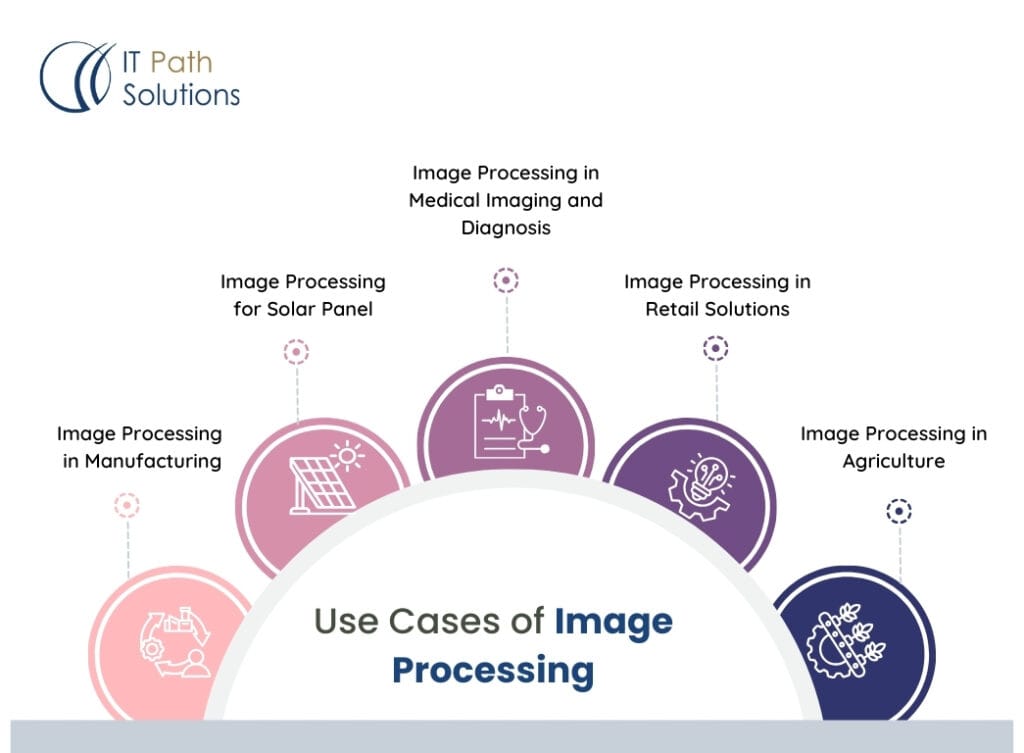Image Processing: Transforming Industries with Smart Insights
Keyur Patel
September 12, 2025
8 min
Image processing is changing the way businesses operate across industries like manufacturing, healthcare, retail, and finance. By analyzing images, companies can uncover hidden details, automate tasks, and make smarter decisions.
Think about it—manufacturers can detect product defects in real time, doctors can diagnose diseases more accurately, and retailers can track customer behavior to improve shopping experiences. The possibilities are endless!
In this blog, we’ll break down what image processing is, how it works, and why it’s a game-changer for businesses. Plus, we’ll explore real-world examples of how different industries are using it to boost efficiency and solve challenges. Let’s dive in!
What is an Image and What is Image Processing?
An image is a collection of pixels, the total number of pixels defines how the image will appear on the screen. The height and width of the image decide the number of pixels. For example, if the height is 400 and the width is 300 of an image, the total number of pixels in it is 12,000.
Now when it comes to deciding the image’s color, here are a few important things to consider. Each pixel is represented by a range of values between 0 and 255 and is defined as grayscale. Here, 0 stands for black, and 255 is pure white, the other pixels are in between that range. For colored images, the three integers represent the intensity of Red, Green, and Blue colors. The image processing is performed on this image, pixel by pixel. Image processing works by manipulating these pixels, one at a time.
On the other hand, Image processing is a computer vision technique that helps in studying, enhancing, and extracting valuable insights from digital images that are captured. By applying signal processing methods to digitally acquired images and processed as 2D signals, meaningful information can be derived.
The five main types of image processing are:
- Visualization:
- Recognition;
- Sharpening and restoration;
- Pattern recognition;
- Retrieval.
| Visualization | Finding objects not visible perfectly in an image |
| Recognition | Distinguishing and detecting objects in an image |
| Sharpening and Restoration | Enhancing the image from the original image |
| Pattern recognition | Identify the patterns around the image |
| Retrieval | Extract an image from a large pool of images to match the exact case. |
If we look at the numbers,
The digital image processing industry is expected to have a compounded growth rate of 22.8%. And might reach a CAGR of 23.3% by 2028. Such huge figures only reflect the popularity of image processing and its implementation in various industries.
What are the various components of Image Processing:

Computer:
An image processing system can be established by using a standard computer or by using a high-performance supercomputer. If you wish to achieve more specialized tasks, you can use a custom-built computer.
Hardware for image processing:
Use a specialized digitizer and hardware with an Arithmetic Logic Unit (ALU) to carry out arithmetic and logical operations on the digital images.
Storage:
The three primary types of storage that you primarily need for digital image processing are 1. Short-term storage for immediate processing, 2. online storage for quick recall, 3. Archive storage for long-term preservation of image data.
Camera sensors:
Digital cameras are used to capture images using CCD and CMOS sensors. CCD is used to detect the energy emitted by the object and CMOS is a digitizer used for transforming physical sensing devices into digital form.
Image display:
This is self-explanatory, the digital images are displayed.
Software:
The image processing needs specialized modules to perform the image processing function.
Hardcopy equipment:
To initiate a hardcopy of digital images, you will need laser printers, film cameras, inkjet printers, optical and CD ROM discs, etc to record pictures.
Networking:
A secure network is necessary for circulating the images with a specific bandwidth for image processing.
What are the fundamental steps in digital image processing?
The following are the basic steps used for image processing:
- Image is first either captured or retrieved from the source and necessary adjustments are initiated.
- The image in the test is adjusted to suitable brightness and contrast as required.
- Image restoration is performed using mathematical or probabilistic models to improve the quality of the image tested.
- Using various color modeling techniques, the digital images are processed for better visualization.
- The images are further segmented into small regions, often referred to as wavelets to enable efficient data compression.
- The captured images are compressed to a size suitable for image transmission.
- Further, the images are processed for segmenting into various objects.
- The segmented image is represented and described in a suitable form.
- Image recognition labels the image to an object.
How is image processing different from computer vision?
The ultimate goal of image processing or computer vision is the same:- Making digital images interpretable.
Image processing works on improving the quality of an image, whether by improving contrast, sharpening details, or enhancing colors. The corrected images can be used further for medical purposes like scanning or creating visually stunning graphics.
Computer vision, on the other hand, goes beyond traditional scanning and extracts meanings from the images. It processes images to understand their behaviors, context & patterns. It is important to note here that high-quality images can give better results as compared to low-quality images.
This is the major difference between Computer Vision and Image processing. Let us now delve into some important use cases that will bring innovation and increase efficiency across multiple industries.
Here are a few use cases of image processing for you to explore.

If you have any specific integration requirements, please feel free to contact IT Path Solutions.
Image Processing in Manufacturing:
High-quality standards are paramount in manufacturing industries. Whether producing electronics or large-scale machinery, industries often face challenges in extracting accurate information from images to ensure precision.
By applying the right image-processing techniques, these challenges can be overcome. For example in the automotive sector, well-designed image processing helps in identifying every part of a car, be it its color, seat style, parts of machines, etc. This not only improves efficiency but also enhances overall product quality.
As the car to be tested passes through the computer vision system assembly line, every point is meticulously checked, from paint on the car, dent, scratch, or any other tiniest imperfections.
Image processing in healthcare manufacturing also acts like a wonder. It can identify drug labels, check the consistency of the drug packaging, and increase the accuracy with which the supply chain model operates. This helps in streamlining the production processes, benefiting both manufacturers as well as consumers.
Examples:
BMW and Nestle use image processing techniques to ensure high quality of products.
Enhance predictive maintenance in manufacturing using image processing:
Image processing can have its fair share of credit in ensuring that no system faces any downtime in the manufacturing industry.
By utilizing image processing sensors and cameras placed in front of the machinery it can detect even the tiniest hints of wear and tear.
The early detection of bad conditions or any wear and tear helps in scheduling maintenance before any major breakdown happens. This ensures smooth and uninterrupted operations on the production line.
Image processing for solar panel efficiency monitoring:
For solar panels to operate in their best condition, it is crucial to keep a check on overheating of the solar panels. While solar panels absorb sunlight and convert it into electricity, excessive heat can permanently damage its efficiency.
Image processing captures and analyzes solar panels to identify areas that are overheated or experiencing temperature irregularities.
You can use these insights to initiate timely actions that enhance the efficiency and longevity of the solar panels.
Image processing in medical imaging and diagnosis:
Image processing will revolutionize the way modern healthcare operates. The advanced algorithms and image processing systems can precisely analyze the image and check for any abnormalities, such as tumors, fractures, internal bleeding, etc.
Examples:
Mayo Clinic and IBM Watson Health use image processing for managing patient care, assisting radiologists in interpreting medical images, and more.
Image processing in retail solutions:
Modern requirements need modern solutions. You can use image processing technology to track customer movements, preferences, and behaviors within retail spaces. Using the analyzed data, retailers can identify areas where it receives maximum traffic in the store, and understand how effective store placement is.
Similarly, image processing can also be effective in managing inventory. You can use cameras, sensors, and advanced algorithms to monitor product levels in real-time. This helps in maintaining optimal stock levels and reduces the risk of overstocking or stock outs.
Examples:
Walmart makes use of image processing for inventory management in the warehouse.
ASOS, a leading fashion retailer, uses visual search technology to help their customers find clothing.
Image Processing in Agriculture:
You can train image processing algorithms to monitor plant health more efficiently and sustainably. Using drones and satellites, coupled with image processing techniques, agriculturists can identify plant stress, spot diseases, estimate crop yield, etc.
Examples: Climate Corporation uses image processing for crop monitoring and yield predictions.
Conclusion:
Image processing is revolutionizing industries by making operations smarter, faster, and more efficient. From detecting defects in manufacturing to improving medical diagnostics and optimizing retail experiences, its impact is undeniable.
As technology continues to evolve, businesses that embrace image processing will gain a competitive edge by automating tasks, reducing errors, and making data-driven decisions.
If you’re looking to integrate image processing and AI development into your business but aren’t sure where to start, we’re here to help. Let’s turn your vision into reality—get in touch with us today!

Keyur Patel
Co-Founder
Keyur Patel is the director at IT Path Solutions, where he helps businesses develop scalable applications. With his extensive experience and visionary approach, he leads the team to create futuristic solutions. Keyur Patel has exceptional leadership skills and technical expertise in Node.js, .Net, React.js, AI/ML, and PHP frameworks. His dedication to driving digital transformation makes him an invaluable asset to the company.


